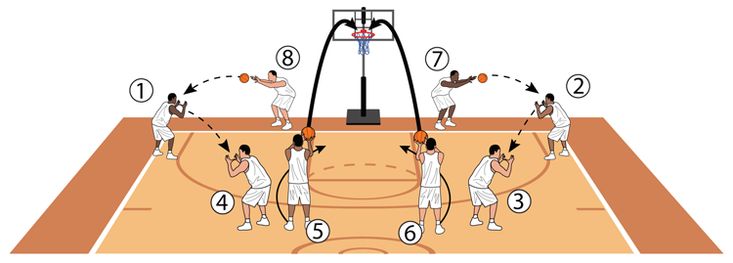Read and React Offense
The “Read and React” offense is a basketball offensive strategy that emphasizes player decision-making and adaptability. It was developed by coach Rick Torbett and focuses on creating a system that doesn’t rely heavily on set plays, but rather on players reading the defense and reacting accordingly. Here’s an overview of the Read and React offense:
- Basic Principles: The offense is built upon a set of core principles that guide player actions. These principles include passing, cutting, screening, spacing, and attacking the basket.
- Player Actions: In this offense, players are not restricted to specific positions or roles. Instead, they learn a series of actions that can be combined based on the flow of the game and the reactions of the defense.
- Layered Structure: The Read and React offense is structured in layers. Each layer introduces new actions and options, building upon the previous layers. This allows the offense to become progressively more complex as players become more familiar with the system.
- Continuous Movement: Players are constantly moving on the court, cutting, screening, and spacing themselves effectively. This movement keeps the defense guessing and creates opportunities for open shots, drives to the basket, and passing lanes.
- Decision-Making: Players are required to read the defense and make decisions based on what they see. For example, if a player’s defender helps on a drive, the player can kick the ball out to an open teammate for a shot.
- Spacing: Proper spacing is crucial in the Read and React offense. Players are taught to maintain appropriate distances from each other to stretch the defense and create driving lanes and passing angles.
- Ball Movement: The offense emphasizes quick ball movement. When players make passes, they are expected to cut or screen away from the ball, creating additional options for their teammates.
- Screens and Cuts: Players use screens to create open shots or driving opportunities. If a teammate is denied the ball, they react by cutting to create new passing lanes or drive opportunities.
- Transition Play: The Read and React offense can be seamlessly transitioned into fast breaks or defensive rebounds. The continuous movement and decision-making skills help exploit defensive mismatches and unorganized transitions.
- Adaptability: The offense is designed to adapt to various defensive strategies, whether it’s man-to-man, zone defense, or switching. Players adjust their actions based on the defense’s reactions. Also, read about Basketball Inbounds Plays
Understanding the Read and React Offense
At its core, the Read and React offense is built on the philosophy of “reading” the defense and reacting accordingly. Unlike traditional offenses that rely on structured plays, this system grants players the freedom to make decisions on the fly based on how the defense is positioned. This flexibility not only keeps opponents guessing but also empowers players to exploit openings and mismatches.
Key Principles of the Offense
Reacting to Defensive Pressure
In the Read and React offense, players are taught to react swiftly to defensive pressure. If a defender closes in, the player with the ball can make a quick pass to an open teammate or drive to the basket. This proactive response keeps the defense off balance and creates scoring opportunities.
Continuous Player Movement
The offense thrives on constant movement. Players without the ball engage in cuts, screens, and rotations, forcing defenders to make split-second decisions. This perpetual motion confuses the defense and opens up passing lanes and shooting opportunities.
Emphasis on Spacing and Positioning
Proper spacing is a fundamental aspect of the Read and React offense. By maintaining optimal distances between players, the offense creates room for penetration, kick-outs, and open shots. Players are encouraged to position themselves strategically to exploit defensive gaps. Discover more about How to Beat a 2-2-1 Press Defense in Basketball
Implementing the Read and React Offense
Establishing a Solid Foundation
To successfully implement the Read and React offense, coaches must ensure players have a strong foundation in fundamental basketball skills. This includes passing, dribbling, shooting, and court awareness.
Teaching Players to “Read” the Defense
Players must develop the ability to read defensive movements and react accordingly. This involves identifying overplays, helping defenders, and recognizing when to drive or pass. This skill comes with practice and game experience.
Building Chemistry and Communication
Seamless execution of the offense requires players to communicate effectively and understand each other’s tendencies. Regular practices and team-building activities enhance chemistry and promote trust on the court.
Advantages of the Read and React Offense
Confusing Opponents with Variability
The unpredictable nature of the Read and React offense makes it challenging for opponents to devise effective defensive strategies. With no set plays to scout, defenders struggle to anticipate offensive actions, leading to defensive breakdowns.
Exploiting Mismatches Effectively
The offense encourages exploiting mismatches as players recognize and capitalize on advantages. A smaller player posted up against a taller defender or a quicker guard driving against a slower opponent can lead to high-percentage scoring opportunities.
Fostering Players’ Basketball IQ
The Read and React offense sharpens players’ basketball IQ as they learn to make split-second decisions based on real-time observations. This intelligence translates to better decision-making in critical game situations.
Challenges and Considerations
Learning Curve and Patience
Implementing the Read and React offense requires patience. Players and coaches must invest time in learning and mastering the system. The initial learning curve can be steep, but the rewards are worth it.
Defensive Adjustments
Opponents will attempt to counter the Read and React offense with defensive adjustments. Coaches and players need to adapt and develop strategies to counter these tactics.
Coaching Tips for Success
Emphasize Skill Development
Players must have a strong skill set to excel in the Read and React offense. Coaches should dedicate time to skill development drills and exercises.
Repetition and Scrimmages
Repetition is key to mastery. Regular scrimmages and practice games allow players to implement the offense in a simulated game environment.
Encourage Freedom Within Structure
While the offense promotes freedom, players should understand that it operates within a structured framework. Freedom to make decisions should be balanced with maintaining offensive cohesion.
Real-World Examples
Gonzaga Bulldogs: A College Basketball Powerhouse
The Gonzaga Bulldogs have embraced the Read and React offense, using it to consistently outscore opponents. Their fluid ball movement and player reactions have made them a force to be reckoned with in college basketball.
San Antonio Spurs: NBA’s Read and React Pioneers
The San Antonio Spurs, under the leadership of Coach Gregg Popovich, popularized the Read and React offense in the NBA. Their success with the system led to several championships and a lasting impact on the league.
The Future of Basketball Offense
As the game of basketball evolves, the Read and React offense is likely to play an increasingly significant role. Its emphasis on adaptability, player decision-making, and teamwork aligns with the changing dynamics of the sport.
Conclusion
In a world of scripted plays and rigid strategies, the Read and React offense shines as a beacon of flexibility and creativity. This innovative approach challenges players to think on their feet, make split-second decisions, and work cohesively as a unit. With its potential to confuse defenses, exploit mismatches, and elevate players’ basketball IQ, the Read and React offense is rewriting the playbook on how points are scored in basketball.
Frequently Asked Questions
Q. How long does it take for a team to fully grasp the Read and React offense?
A. The learning curve varies, but it generally takes several months of consistent practice and gameplay for players to become proficient.
Q. Can the Read and React offense be effective at all levels of basketball?
A. Yes, the principles can be adapted to suit different skill levels, but implementation may vary.
Q. Are there any drawbacks to the Read and React offense?
A. While effective, it requires players to have a high basketball IQ and demands patience during the learning phase.
Q. Is the Read and React offense more suitable for fast-paced or slow-paced games?
A. It can be tailored to both styles of play, making it versatile and adaptable.
Alina is a passionate basketball player with a love for the game that knows no bounds. With years of experience on the court, she brings unmatched skill and dedication to her team. Alina’s commitment to excellence both on and off the court sets her apart as a leader and motivator. Whether she’s driving to the basket or encouraging her teammates, Alina’s enthusiasm and sportsmanship shine through. As a valuable member of the basketball team, Alina’s presence elevates the spirit and performance of the entire squad.







